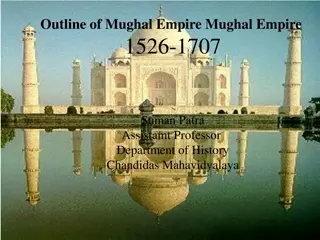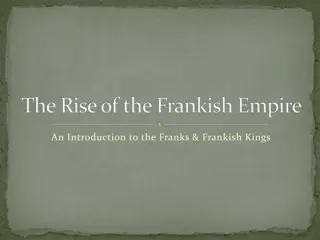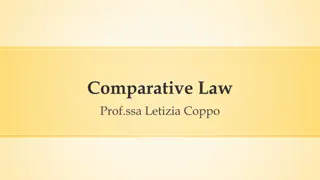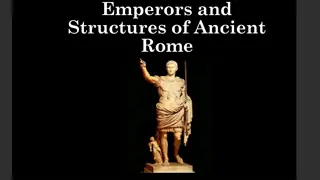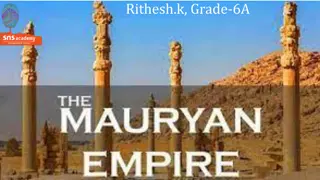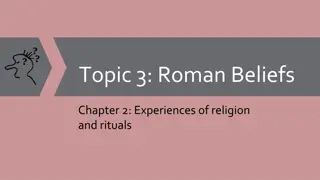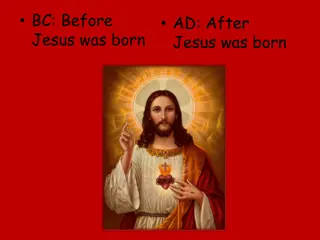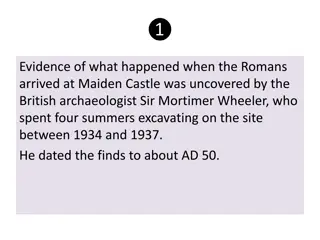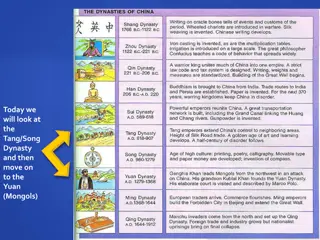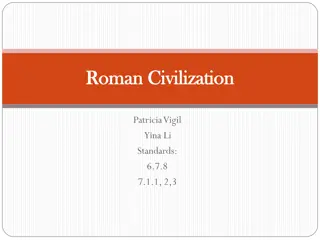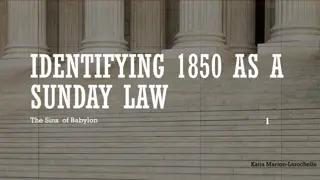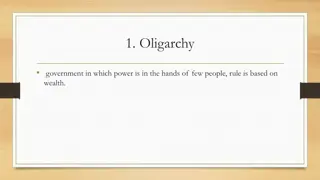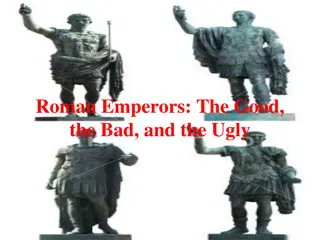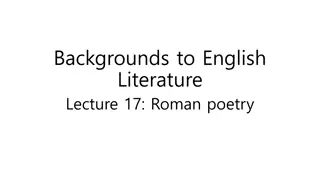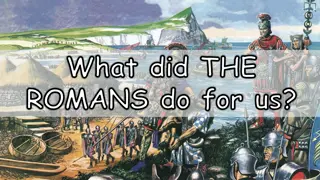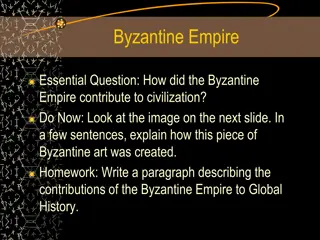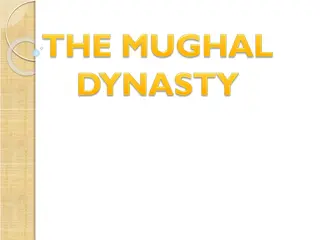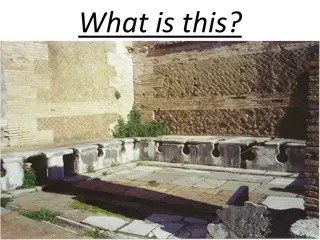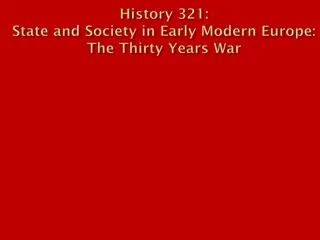The Transformation of the Roman Empire: Constantine and Theodosius
The lecture delves into the significant reigns of Constantine the Great and Theodosius the Great in the context of the Roman Empire's historical changes. It explores the social and ecclesial impact brought about by Constantine's policies and examines the political landscape during the early fourth century, with a focus on Diocletian's division of the Empire. The presentation also highlights the power struggles that ensued after Diocletian's retirement, leading to Constantine's rise as Augustus.
Download Presentation

Please find below an Image/Link to download the presentation.
The content on the website is provided AS IS for your information and personal use only. It may not be sold, licensed, or shared on other websites without obtaining consent from the author. Download presentation by click this link. If you encounter any issues during the download, it is possible that the publisher has removed the file from their server.
E N D
Presentation Transcript
Lecture 4 Constantine the Great and Theodosius the Great Dr. Ann T. Orlando 13 September 2018 1
Introduction Review of Third Century Importance of Constantine Social and Ecclesial Changes Precipitated by Constantine Theodosius 2
Review of Third Century Increased pressure on Rome from Persia and northern barbarians Political instability; murder and succession of generals as emperors Between Decius and Diocletian, average reign < one year Empire-wide persecution of Christians under Decius Many Martyrs; also many lapsed Order and stability restored under Diocletian 3
Political Situation in early Fourth Century: Diocletian Diocletian becomes emperor in 284. Very strong ruler Decides that best way to protect Empire is to divide it between two Augusti (East and West) supported by two appointed Caesars (Augusti in waiting) Modeled on Five Good Emperors of Second Century Unleashes worst persecution of all; Great Persecution 303 - 311 Manages to retire and force his co-Augutus, Maximian, to retire with him (305) Leads to renewed tensions in Empire Briefly returns to power in 308 to try and restore order 4
Map of Roman Empire: Diocletian s Divisions http://www.unc.edu/awmc/awmcmap45.html 5
After Diocletian A few problems with Diocletian s plan: Both Augusti and both Caesars headed their own armies and areas of influence Except for Diocletian himself, the three other members of this tetrarchy saw this scheme as a way to take over the Empire when Diocletian died When Diocletian retires, political intrigues and battles break about among the successors: Constantius, Augustus, controlled England and Gaul, father of Constantine Severus, Caesar, ruled Rome Maximius, Caesar in Greece Galerius, Augustus, in East When Constantius dies, his troops proclaim his son, Constantine, Augustus (c. 310) 6
(St.?) Constantine the Great (c. 280-337) Key battle in Constantine s take- over of entire Empire was battle of Milvian bridge over Tiber in Rome against Maxentius, son of Maximian in 312. Constantine credits his victory to a vision he had in which he was told to go into battle with the Christian symbol Troops carry chi-rho on their shields By 313 Constantine has captured all of the Empire and officially declared that Christianity was to be tolerated (Edict of Milan) http://harpy.uccs.e du/roman/constant .jpg 7
Importance of Constantine Victory of Constantine most important event in political-ecclesial history Signaled beginning of the end of old Roman religious system Signaled the beginning of the Church as a political force 8
Constantine and Church in Rome Before he leaves Rome after Milvian Bridge victory, he gives most of Rome to the Pope That is, he gives the land and buildings of his enemies to Pope Most important of these is the Lateran Palace (St. John Lateran) Eighth Century Donation of Constantine Church overnight becomes the most important landholder in Rome Converts some pagan temples into Christian churches (for example, Pantheon) But most Christian Churches built in a basilica model Builds new Churches, especially at site of martyrdoms with money from Constantine (for example, Vatican) 9
Constantine the Great and the Church Beyond Rome Builds Churches, with his mother Helen, in Holy Land (Church of Holy Sepulcher in Jerusalem, Church of Nativity in Bethlehem) Moves against the Donatists in North Africa Calls Council of Nicea to resolve the Arian controversy: The Nicene Creed Establishes New Rome : Constantinople Dies in 337 (after murdering his wife and eldest son); baptized by an Arian bishop shortly before he dies Considered a saint in the East Initial reaction of Church is that the Christian kingdom has arrived 10
Major Social Changes in 4th C Due to Constantine and his Successors Christian clergy given tax relief Christian clergy could use the imperial post system (cursus publicus) Communicating Documents Transportation for clergy around empire if on Church business Churches could receive legacies Sunday as a day of rest Christian could not charge another Christian interest on a loan (sin of usury) Crucifixion prohibited No branding of prisoners because mars image of God 11
Constantine and the Bishops Constantine recognized the important social (and soon political) organization of bishops Declares the office of bishop to be an ordo, a separate legal class By decree bishops could act as judges in their diocese (Roman administrative province) Marriage Inheritance Contracts Increasingly even pagans used ecclesial courts Bishop s ruling considered pro sanctis, as sacred Very limited ability to appeal 12
Bishops Become Most Important Leaders in Society Oversee construction of new public church buildings Usually on a basilica model Basilica was a large Roman public administrative building Few pagan temples were converted to churches Building projects, largely funded by Roman government, gave bishops control over most local civic public works projects Bishops become important local economic sources of patronage (jobs) 13
Major Issues Within the Church Who are heroes now that there are no longer martyrs? How to deal with new members who may be joining Church because it is politically expedient? What is relation between bishops and civil rulers? Evolves very differently in the East and West 14
Nicaea Council of Nicaea called by Constantine in 325 to resolve Arian controversy and bring unity to Church, and therefore unity to Empire Virtually all Eastern bishops and some Western bishops attended Bishop Alexander of Alexandria succeeded in routing the Arian bishops 15
Political Impact of Nicaea Establishes precedent of the emperor engaging in ecclesial affairs Constantine seen not only as a bishop but as another apostle Constantine presides over Council Constantine said to approve the Creed 16
Arianism after Nicaea Continued to be a very potent heresy Also, politically well connected: Constantine may have been baptized by an Arian bishop His son, Constanstius, d. 360 took side of Arians; Sent Arian missionaries to Germany Alaric and the Goths who sacked Rome in 410 were Arian Christians His cousin, Julian the Apostate, d. 363 tried to return the Empire to paganism Of the claimants to Empire after Julian Valantinian I in West, pro-Nicene (although his mother was an Arian) Valens in East was a semi-Arian Finally settled with Theodosius the Great, Council of Constantinople, 381, promulgates Nicene-Constantinople Creed, What we now have Note structure of CCC 17
So Who Was Julian the Apostate? Nephew of Constantine the Great Constantine was succeeded by his sons Constans, Constantius and Constantine (Julian s cousins) Constantius consolidated power through intrigue and murder, including the murder of Julian s father and older brothers Julian as a boy sent to study in Athens may have known Sts. Basil Great and Gregory Nazianzus there; pretended to be a Christian After his studies, he commanded Roman troops in Gaul When he becomes emperor he tries to restore paganism Dies in battle against Persians
Classic Battle: Adrianople Between Roman troops under Emperor Valens and Goths 9 August 378 Roman army is completely destroyed Valens disappears in the carnage Most of the 40,000 Roman troops are lost Often thought to signal beginning of end of Roman Empire Last Western Emperor 479 Last Eastern Roman Emperor 1453 Still studied today by military historians Artifacts from battle are still being discovered http://www.thenagain.info/W ebChron/Mediterranean/Adria nople.html
(St.?) Theodosius the Great While Constantine promoted Christianity, Theodosius also moved against Roman pagan institutions Born in Spain in 347, succeeds emperor Valens, reigned 379-395 Last Roman emperor of full (Western and Eastern) Empire His sons Arcadius and Honorius succeed him in the East and West, respectively Baptized in 380 an Orthodox (Nicene) Christian 20
Theodosius and the Pagans First Roman emperor to reject title pontifex maximus , that is chief priest and defender of Roman religion Declared Nicene Christianity the official religion of the Roman Empire in 380 Outlawed Manichaeism and pagan sacrifices 391 21
Pontifex Maximus Pontifex: priest of high ranking college of priests in Rome Responsible for Roman calendar Responsible for family civil law such as adoptions and inheritance Recording events (births, deaths) Pontifex Maximus: Leader of the pontifex college of priests Elected office With Julius Caesar, also becomes a political office After Constantine, the Bishop of Rome starts to use title of pontifex, circa end of 4th C
Theodosius and the Bishops Called the Second Ecumenical Council, First Council of Constantinople Placed St. Gregory Nazianzus as presider Reinforced Nicaea Expanded decrees on Holy Spirit (proceeds from the Father) Engaged in several controversies with St. Ambrose When Theodosius dies in Milan, Ambrose gives the funeral oration 23
Election of Pope Damasus (r. 366-384) Civil and economic importance of Papacy in city of Rome dramatically increases after Constantine Election of the pope becomes a civil and economic matter as well as religious Riots break out with much blood shed between Damusus supporters and those of his rival, Ursinus Damasus election affirmed by emperor (Gratian and Theodosius)
Importance of Pope Damasus Tasks Jerome to translate Scripture to Latin Undertakes the translation of liturgy to Latin Asserted Papal primacy from Jesus (Matt 16:16) through Peter That is, importance of Bishop of Rome beyond Apostolic Succession First organization of papal archives
Ambrose and Theodosius Burning of Jewish synagogue in Callinicum in Mesopotamia Theodosius wanted Christian community to pay to rebuild synagogue Ambrose wrote scathing sermon saying not right for Christians to build synagogues Theodosius backed down Theodosius massacred people of Thessalonica because they had rioted and killed Roman administrators Ambrose excommunicated Theodosius Theodosius publicly repented
Eastern Roman Emperors Constantine (East and West) Council of Nicaea Theodosius I, Great (379-395) (East and West) Council of Constantinople I Arcadius (son of Theodosius) (395-408) Conflicts with John Chrysostom Theodosius II (408-450) Son of Arcadius Council of Ephesus St. Pulcharia and Marcion (450-457) Pulcharia daughter of Theodosius II Council of Chalcedon 27
The Ecumenical Councils Nicaea I, 325, called by Constantine the Great Condemned Arianism Son of one substance with the Father Nicene Creed Constantinople I, 381, Called by Theodosius the Great Affirmed divinity of Holy Spirit Modified Creed; what we have now Ephesus, 431, called by Theodosius II Condemned Nestorius, Patriarch of Constantinople Jesus was not two separate persons, but one person both human and divine Mary as Theotokos Mother of God Chalcedon, 450, called by Empress Pulcharia at request of Pope St. Leo I (the Great) Condemned monophysites: single nature Christ has two natures: human and divine (Leo s Tome Second Council of Constantinople, 553, Called by Justinian Condemned Theodore of Mosuestia Third Council of Constantinople, 680 Called by Emperor Constantine Pogonatus Condemned Monothelete and Pope Honorius 28
Assignments CoG V.24-26, XIX.4-8 (required) Hitchcock, Ch.3 Tanner on early councils, pp 41-80. (optional) Prepare paper and discussion (required) due next Tuesday 29


